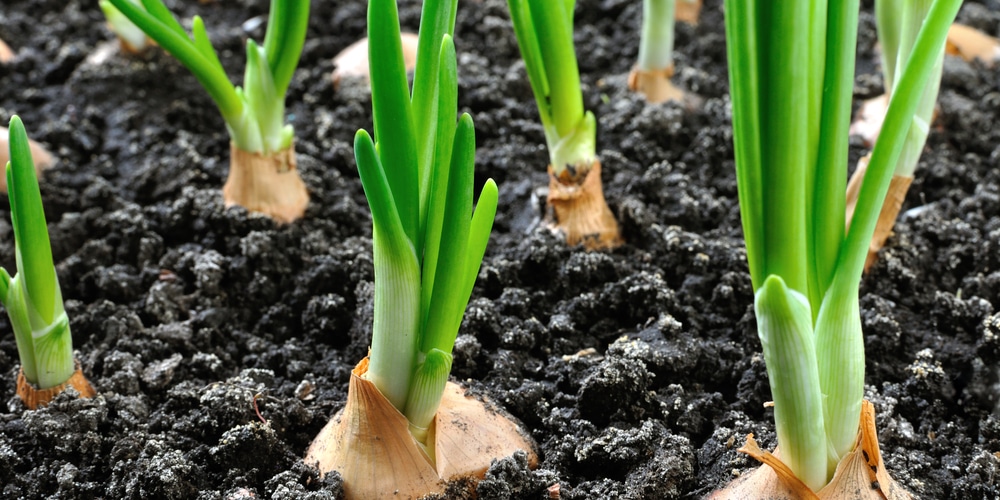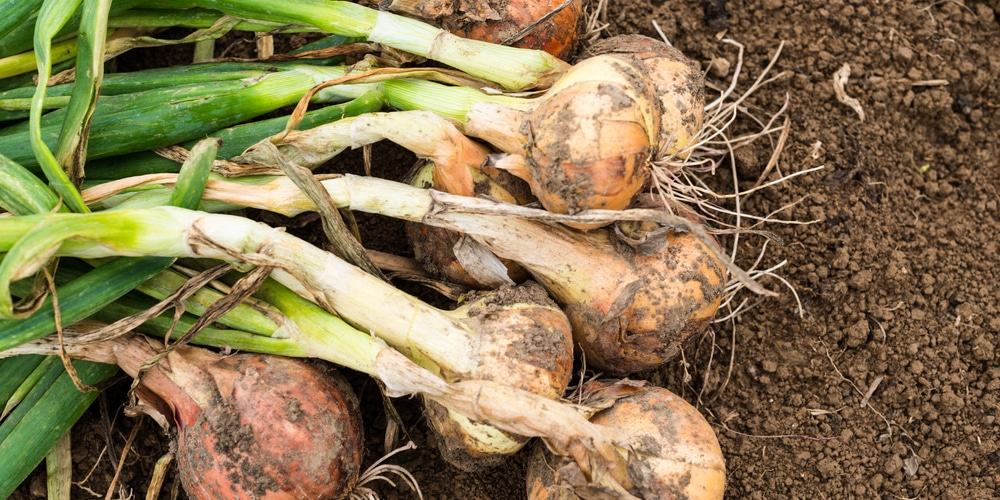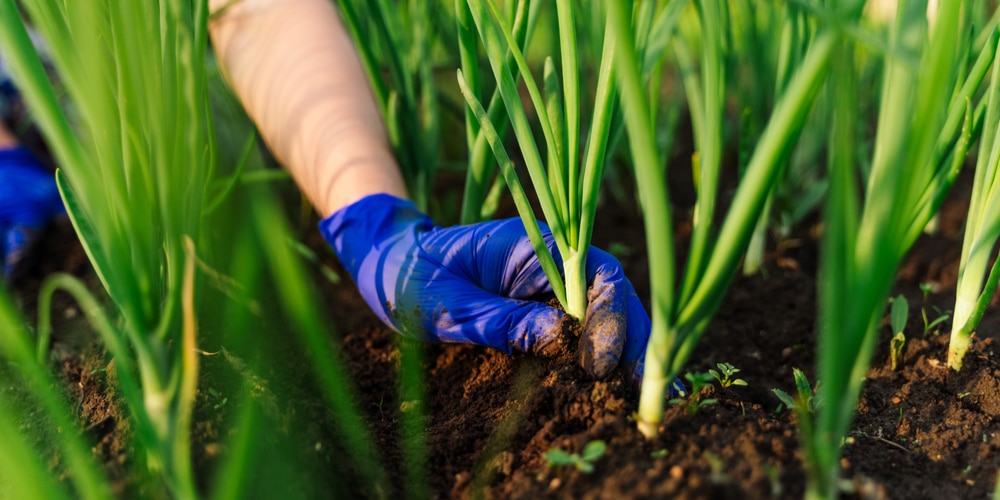The “Short” Version
| Climate Zone | Fall Planting | Spring Planting |
|---|---|---|
| Zones 3-5 | Not recommended | March to April |
| Zone 6 | October | March |
| Zone 7 | October to November | February to March |
| Zone 8 | September to October | January to February |
| Zone 9-10 | October to December | Not recommended |

Spring Planting: Recommended for cooler climates (Zones 3-6), planting as soon as the soil is workable in spring, leading to a summer harvest.
Notes:
- Short-day onions are best for Zones 7-10, where winters are milder, and days are shorter.
- Long-day onions are suited for Zones 3-6, where there are longer daylight hours in summer.
- Intermediate-day onions can grow in most zones but are optimal for Zones 5-6 and 7-8.
Remember, local microclimates and weather variations can affect planting times. Adjustments may be needed based on the current year’s conditions. Always prepare your soil with compost or aged manure to ensure rich, well-drained conditions for your onions.
Onion Varieties and Climate Zones
Selecting the right onion variety and understanding its suitability to specific climate zones is essential for a successful crop.
Onions are adaptable to various climates but thrive in specific conditions determined by their variety.
Short-Day Onions flourish in southern regions where the daylight length ranges from 10 to 12 hours. These varieties often include types like ‘Stuttgarter’ and ‘Texas Grano’.
Intermediate-Day Onions require 12-14 hours of daylight and are suitable for gardeners in the middle regions of the country.
Long-Day Onions demand approximately 14-16 hours of daylight and are best suited for the northernmost areas.
Here’s how to identify suitable varieties for different zones:
- Zone 5a: This region encompasses a balance that can sustain both Intermediate and Long-day onions. One may choose to plant a variety such as ‘Ebenezer’ which keeps well.
- Warmer Zones: Gardeners should focus on Short-day onions that will bulb as the daylight is limited.
Outdoor enthusiasts must also consider their local climate beyond the USDA zones. Factors like altitude and microclimates affect growth patterns.
Onion varieties also differ in their storage capabilities, flavor profiles, from mild and sweet to robust and pungent, and in their shape and color.
Gardeners should choose varieties not only for their climate but also based on their culinary preferences and storage needs.
When planning an onion planting calendar, gardeners must synchronize the variety’s daylight needs with local daylight hours to maximize growth and flavor.
Planting at the wrong time can lead to underdeveloped bulbs or premature bolting.
Soil Preparation and Fertilization
Proper soil preparation and fertilization are the bedrocks for healthy onion growth, affecting everything from plant health to the flavor of the harvest.
Testing Soil and Adjusting pH
They start by understanding their soil’s current condition and enhancing it with the right amendments and fertilizers.
Before they plant, gardeners should test the soil to determine its pH level. Onions thrive in soil with a pH between 6.0 and 6.8.
If the soil is too acidic, gardeners can raise the pH by applying lime; if it’s too alkaline, they can lower the pH using sulfur.
- Soil pH Preference for Onions:
- Ideal range: 6.0 – 6.8
- To increase pH: Apply garden lime
- To decrease pH: Incorporate sulfur
Organic Matter and Fertilizer Application
Organic mulch is a great way to improve soil fertility and structure. Gardeners should mix in well-decomposed organic matter before planting.
A balanced fertilizer, such as 10-20-10, is recommended at the time of planting due to onions’ higher phosphorus needs which encourage root development and bulb growth.
- Application Steps:
- Dig a trench 4 inches deep and 4 inches wide.
- Apply 1/2 cup of fertilizer per 10 linear feet.
- Cover with 2 inches of soil.
- Fertilizer Frequency:
- Seedlings: When onions have 3-5 leaves.
- Growing Season: Every 2-4 weeks.
- Bulb Formation: Cease fertilization.
The right balance of organic matter and nutrients gives onions the best growing conditions to produce flavorful and robust bulbs.
Optimal Sowing Times
When aiming for the best yield and flavor, timely sowing plays a crucial role.
Gardeners should pay close attention to local climate conditions and the unique growth cycle of onion varieties to determine the best planting schedule.
Indoor Seed Starting
Timing: Gardeners should start seeds indoors approximately 6-8 weeks before the last expected frost date for their region.
- Zones 3-9: These are ideal for onion growth, with sowing typically commencing in late winter.
Conditions:
- Temperature: Maintain soil at 70-75°F (21-24°C) for optimal germination.
- Light: Position in a sunny window or use grow lights to ensure sufficient light.
Process:
- Plant seeds ¼” deep in seed starting mix.
- Water regularly to keep soil moist.
- Harden off the seedlings by gradually exposing them to outdoor conditions over one week.
Direct Sowing and Transplanting
Timing: Transplanting seedlings or direct sowing should occur after the danger of frost has passed, typically in early spring.
- Seedlings: Transplant hardened-off onion plants, spacing them 3-4″ apart.
- Rows: Allow 1-2 feet between rows to accommodate growth and aid in maintenance.
Conditions:
- Soil: Well-drained, fertile soil with a pH of 5.5-6.5 is ideal.
- Sunlight: Full sun is necessary for onions to develop properly.
Process:
- If using sets, plant them about 1″ deep and space them 4-5 inches apart.
- Fertilize with a balanced 10-20-10 fertilizer at planting and follow up with a nitrogen-focused fertilizer every 2-3 weeks for robust growth.
- Cease fertilization once the bulbing process begins, indicated when onions push the soil away.
Onion Growth Phases and Care
Understanding the growth phases of onions and the proper care during each stage ensures a successful harvest with optimal flavor. This section focuses on key factors such as watering, weed control, pest and disease management, and bolting prevention.
Watering and Weed Management
Onions require consistent moisture, especially during the early stages of development. They should be watered thoroughly once a week, providing 1 inch of water to the soil.
Excess moisture or irregular watering can lead to poor bulb development.
For weed control, mulching is effective. The use of organic mulch not only suppresses weeds but also retains soil moisture.
- Watering Frequency: Once a week
- Water Amount: 1 inch
Pest and Disease Prevention
To protect onions from pests and diseases, proactive management is key.
Thrips and onion maggots are common pests, which can be mitigated by using appropriate insecticides and maintaining clean garden practices.
Diseases such as blight and mildew require well-drained soil and crop rotation.
Fungicides may be necessary for certain fungal issues.
- Pest Control: Insecticides, clean garden practices
- Disease Management: Well-drained soil, crop rotation, fungicides
Bolting and Flowering Control
Bolting, or premature flowering, can weaken onion bulbs.
It is often triggered by fluctuating temperatures and can be minimized by selecting suitable varieties for the local climate and ensuring consistent water and nutrient supply.
Once an onion plant bolts, its focus shifts from bulb to seed production, reducing bulb size and storage life.
- Bolting Triggers: Fluctuating temperatures
- Prevention: Climate-appropriate varieties, consistent care
Harvesting and Curing for Flavor Enhancement
Harvesting onions at the right time and employing proper curing methods are crucial steps to ensure enhanced flavor and storage longevity.
Harvest Timing and Techniques
To maximize the flavor of onions, they should be harvested when their tops have bent over and begun to naturally dry, usually 100 to 120 days after planting. This indicates that the bulbs have stopped growing and are at their peak for flavor.
The soil around the onions should be loosened without damaging the bulbs and then they can be gently pulled out. To maintain their quality, onions should be harvested on a sunny day and then left out in the garden for another day or two to dry, if the weather permits.
- Check for readiness: Green tops turning yellow and flopping over
- Loosen soil: Gently loosen the soil around the bulbs
- Harvest carefully: Avoid bruising the onions to prevent decay
Curing Process and Storage Tips
After harvest, onions require a curing process which involves drying them in a well-ventilated space out of direct sunlight. This step is vital to prepare the onions for storage and extend their shelf life.
The roots should be trimmed, and the outermost layer should be dry and papery. Properly cured onions are then stored in a cool, dark place with good air circulation.
- Dry roots: Immediately after harvest to prevent rot
- Cure onions: Lay out in a dry, well-ventilated space for 2-4 weeks
- Store properly: In mesh bags or nets in a cool, dry location
Frequently Asked Questions
When embarking on the journey of cultivating onions, gardeners often have a myriad of questions regarding the process. This section aims to address some of the most common inquiries, providing clear and concise answers to enhance their onion-planting experience.
How can one cultivate onions using bulbs rather than seeds?
Single sets, which are small, dormant onion bulbs, provide a more straightforward planting option compared to seeds.
Plant the bulbs root side down into well-prepared soil so that the very top of the bulb remains just visible above the soil surface.
What is the optimal depth for planting onion bulbs in the soil?
The ideal depth for planting onion bulbs is about an inch into the soil. This depth ensures proper anchorage and space for the bulbs to develop without being so deep that growth is hindered or so shallow that they’re prone to displace.
What techniques are effective for growing onions indoors?
Onions can be successfully grown indoors by planting them in pots filled with potting soil, ensuring the bulb’s depth and width are accommodated.
Regular watering and a sunny location are critical for their growth, with harvest possible once green shoots are established.
What methods enhance the growth rate and flavor profile of onions?
Enriching the soil with well-aged compost before planting greatly benefits growth and flavor. Adequate water, sunlight, and the right choice of soil, preferably loamy with good drainage, also contribute to a more robust and flavorful onion crop.
Which season is most suitable for planting onions to ensure maximum yield?
Onions should be planted in early spring or as soon as the ground is workable. In temperate climates, planting onion sets or seeds 4 to 6 weeks prior to the last expected frost date will lead to optimal growth and yield.
How long should one anticipate the growth period of onions to be from planting to harvest?
The growth period for onions generally spans 90 to 120 days from planting to harvest. The duration varies depending on the variety, local climate, and whether bulbs or seeds are planted.
Observing the onion tops turning brown and falling over indicates they are ready for harvest.
Last update on 2025-06-06 / Affiliate links / Images from Amazon Product Advertising API




